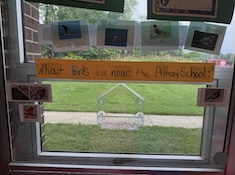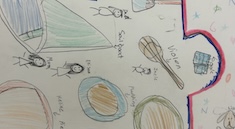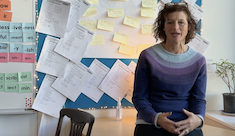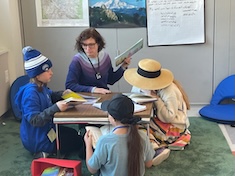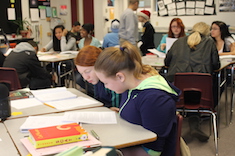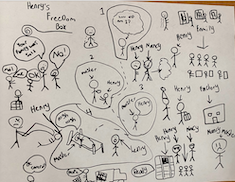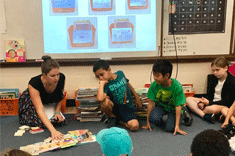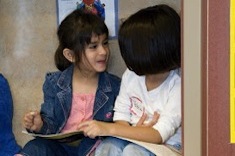Talking and Listening
Listening and speaking—it's the art at the heart of literacy workshops. But there is also a science to how these skills are taught and learned. These resources will show you how to build communication skills in your classroom and school communities.
Latest Content
Protecting Choice and Inquiry with Outdoor Learning Walks
As curriculum shifts in our buildings to feeling more structured, Kate Mills and Tara Barnett reflect on how to protect student choice and opportunities for inquiry. They share a simple and practical way to create opportunity for both choice and inquiry through outdoor learning.
Hidden Lessons: Why Do Relationships Matter? (Part 3)
By the time they reach high school, many students have learned how to survive change, but not always how to make sense of it. They’ve lost friendships, switched schools, experienced family transitions, or even dealt with grief. While they may not always talk openly about these experiences, they often find reflections of them in the books they read. Gretchen Schroeder continues her series about using literature to help students learn important social and relationship skills. She includes student work and a booklist.
Building Trust in Our Classrooms
Tara Barnett and Kate Mills remind us that more important than the physical layout of the classroom or the assessments we’ll give is the type of community we’ll become. Building a brave and enthusiastic community of learners is the foundation that everything else stands on. They share a community-building experience that can be adapted for any age.
Hidden Lessons: How Do We Cope with Challenges and Change? (Part 2)
Literature gives students a safe space to learn about struggle, resilience, and emotional growth without requiring personal vulnerability. Gretchen Schroeder offers a way to focus students’ independent reading to explore coping with challenges and change in life. You won’t want to miss the included young adult booklist. This is the second installment of a series.
What Would You Do?
Tammy Mulligan uses role-play to help her class process different ways to respond to challenging behavior situations. In this video clip, Tammy shares the rationale behind this practice and gives us a glimpse into her students role-playing a situation and their conversations about possible responses.
Community Circle
Bitsy Parks reminds us of the importance of taking time to talk, ask questions, and share thinking in a circle format. Community circle is a practice that strengthens an inclusive community.
Helping Kids Lead Every Day: How to Deepen Small-Group Discussions
Tammy Mulligan shares the step-by-step process she uses with her fourth-grade students so that their small groups are fully managed by students and her teaching is focused on their needs as readers. This is the second installment of a three-part series.
Giving Kids Time and Space to Show Their Brilliance
Mallory Messenger suggests three instructional moves to provide time and space for students to show their brilliance. This is a must-read for anyone who wants to position students to learn.
Quick Take: Everyone Owns the Learning
Tammy Mulligan wants the kids to own the learning in the classroom. Here is one way she helps reinforce the message that everyone has something to offer the learning community.
Sketchnoting in the Library
Gigi McAllister shares how she helped her students get started with sketchnoting during read aloud time. Perhaps like Gigi you aren’t a natural at this format, but you’ll be inspired by the value and ease of introducing this powerful note-taking technique.
Fostering Classroom Dialogue
Gretchen Schroeder shares her big takeaways from reading Inspiring Dialogue. Now more than ever, we need to help students express themselves and claim their voices, because the classroom is one of the last places where we can engage in dialogue about big questions with those who might not share our beliefs.
QuickTake: Using Picture Books to Start Conversations
Gigi McAllister reminds us of the special way picture books can open the doors of conversation.
Zooming In and Stepping Back
Gretchen Schroeder creatively leads her students in chronicling key scenes from a novel so they can evaluate which ones are important and use it as a reference throughout their discussions.
Leading with Empathy in the Classroom
Melissa Quimby offers profound advice for what to do when we notice inattention, excessive questioning, frozen learners, or disruptive behaviors. She recommends letting empathy lead our next steps.
Literary Salons: Book Clubs, Elevated
Inspired by the 17th-century popularity of literary salons, Gretchen Schroeder changed the usual book club routine for her high school students. Literary salons allow people to explore big topics and ideas together without reading the same book. They can create engaging discussions, expose students to new ideas and books, and give them the chance to learn from one another in a relaxed way.
How to Promote Civil Discourse in Your Classroom
Matt Renwick shows how to build the capacity of all students to engage in civil discourse.
Putting Political Talk into Perspective
Gretchen Schroeder encourages teachers to help students know how to talk politics by establishing a positive mindset and attitude when approaching conversations.
Patterns of Prompting
We spend our days prompting whole groups, small groups, and individual learners. We’ve all been in situations where we may not have known what to say. Melissa Quimby offers advice on how to be educators who use language brimming with curiosity and encouragement.
Vertical Whiteboards
Tammy Mulligan shares how vertical whiteboards are a powerful tool to support collaboration and make student thinking visible.
Indoor Walks
Gigi McAlister discovered that using indoor walks is a way to help students engage in their learning and strengthen their learning community through conversations.
Revisiting: Getting to Know My Students
Mandy Robek decided that despite the increasing pressures and time-consuming expectations, she will nourish healthy relationships with students. Here are some tried-and-true practices that she wants to maintain.
Using Drama Games to Approach Difficult Conversations
Gretchen Schroeder is committed to having conversations about race and racism with her high school students. Sometimes it’s difficult to engage students, so Gretchen used drama games as a means to think about concepts metaphorically, then ground them within the text, and, finally, have students apply them to their own lives and the world.
Big, Loud, and Slow: Six Strategies for Better Public Speaking
Matt Renwick worked with a speech therapist after having a stroke. Through this process, he realized powerful teaching points to help students become stronger public speakers.
Stay Curious
Inspired by Ted Lasso’s mantra, “Stay curious, not judgmental,” Julie Cox provides three questions she asks herself and students to remain innovative.
Let’s Write Together: The Importance of Class Books
Jen Court considers whether creating class books is a valuable use of time for today’s young students. As she teases out this question, she realizes class books are a relevant and essential instructional strategy.
Small-Group Conversations About Independent Reading
Jen Vincent scaffolds conversations to help students discuss their independent reading books in small groups…even when everyone is reading a different book! Download and print a copy of the guide to support students in their small-group conversations.
The Language We Use and How It Strengthens Understanding
Suzy Kaback explores the importance of the way teachers use language and invite kids to use theirs. It is the key to knowing ourselves, tuning in to others, and understanding the larger world.
What’s Your Point of View?
Molly James helps us develop an essential point of view for uplifting choice in decision making for young writers and readers.
Questioning My Belief in the Need for Silence
Stella Villalba questioned her belief in the necessity of silent writing time when she began listening to students. In this thought-provoking article, Stella gives direction in how to meet the needs of all students—those who need time to talk and those who need a quiet writing space.
Validating Students
When an excited young reader interrupts the quiet hum of reading workshop, Becca Burk analyzes the important unseen choices students make as learners, and the powerful messages teachers’ responses send.
Browse Content By
Type
Category
- Assessment Tools
- Big Fresh Archives
- Booklists
- Choice Numeracy
- Classroom Design
- Common Core
- Community Building
- Conferring
- Content Literacy
- Digital Literacy
- English Language Learners
- Equity
- Family Relations
- Free Samples
- Guiding Groups
- Leadership
- Literacy Coaches
- Mentor Texts
- Minilessons
- New Teacher Mentors
- Podcasts
- Poetry
- Quote Collections
- Reading Strategies
- Self Care
- Struggling and Striving Learners
- Talking and Listening
- Teacher Study Groups
- Teaching Reading
- Teaching Writing
- Word Study and Vocabulary
Author
- Melissa Quimby
- Nawal Qarooni
- Gwen Blumberg
- Julie Cox
- The Lead Learners
- Hannah Tills
- Josie Stewart
- Ruth Metcalfe
- Mallory Messenger
- Becca Burk
- Jodie Bailey
- Vivian Chen
- Mary Brower
- Tiffany Abbott Fuller
- Stephanie Affinito
- Ruth Ayres
- Leigh Anne Eck
- Heather Fisher
- Shari Frost
- Julie Johnson
- Suzy Kaback
- Gigi McAllister
- Shirl McPhillips
- Melanie Meehan
- Cathy Mere
- Debbie Miller
- Tara Barnett and Kate Mills
- Tammy Mulligan
- Dana Murphy
- Bitsy Parks
- David Pittman
- Brenda Power
- Heather Rader
- Matt Renwick
- Mandy Robek
- Christy Rush-Levine
- Gretchen Schroeder
- Jen Schwanke
- Brian Sepe
- Katherine Sokolowski
- Stella Villalba
- Jennifer Vincent
Grade Level
Choice Literacy Membership
Articles
Get full access to all Choice Literacy article content
Videos
Get full access to all Choice Literacy video content
Courses
Access Choice Literacy course curriculum and training

